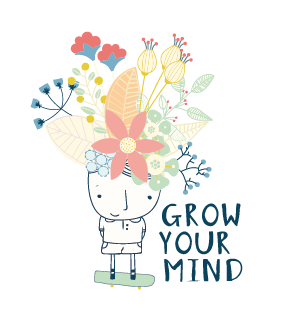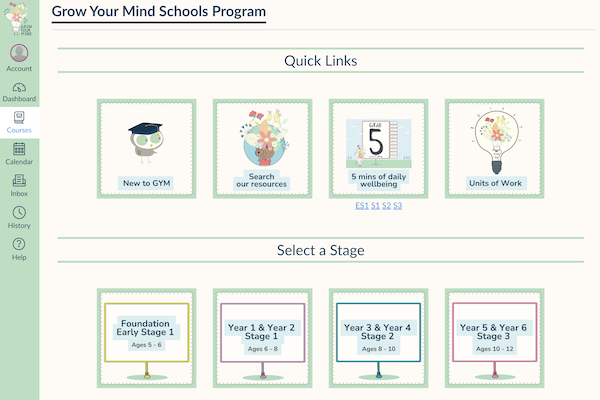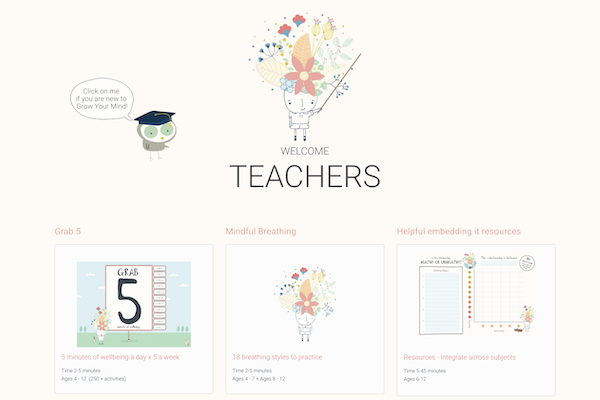5 ways to encourage positive mental health habits and practices with students.
It can be very difficult for young people to navigate their way through the world. They need to learn how to deal with big feelings and new emotions, all while trying to make friends, experience new learning environments and manage their self image as their bodies and hormones change at a rapid rate. While many students are generally happy and feel secure within themselves, there is a growing number of students experiencing poor mental health.
The Australian Institute of Health and Welfare continually monitors different age groups and found that 1 in 5 (20%) young people aged 11–17 had either high or very high levels of psychological distress in their 2013-2014 report. And a survey by the Australian Primary Principals Association (APPA) found that 80% of school leaders believe anxiety is a significant issue for students. Some things that may affect a young person’s mental health in their day to day lives include bullying, body dysmorphia and general anxiety.
The ongoing Covid-19 pandemic has only made it worse. Research is showing that “the indirect effects of the pandemic on children and adolescents are as substantial – if not more so – than the impact of being infected with Covid-19”. Children are also not wanting to leave home as they are increasingly anxious about Covid, according to Associate Professor Nicholas Wood, a paediatrician at the Children’s Hospital Westmead. But with Covid-19 here to stay it is vital for students to learn how to live their ‘new normal’ lives.
Poor mental health can affect student outcomes and behaviours
So, you may be wondering, why are these statistics so important? First and foremost, it affects their behaviour. Children who experience poor mental health are more likely to act out in the classroom, especially if they haven’t been taught how to regulate their emotions.
It can also lead to poor learning outcomes. Students who have low mental health are more likely to have more absences at school, including some who become school refusers entirely. Furthermore, students with a mental disorder ‘in Year 3 were, on average, seven to 11 months behind students with no mental disorder but by Year 9 they were an average 1.5 to 2.8 years behind’ (Education Matters Mag).
Most alarmingly, it has been found in 2015 that ‘suicide and self-inflicted injury was the leading cause of the total burden of disease for young people aged 15–24’.
With this information available to us, it is important for adults to find ways to support the youths in our lives.
5 ways to support positive mental health in your classroom
1. Practice mindfulness
Incorporating mindfulness as a daily exercise in the classroom can be a fantastic way to improve mental health in your students. Frontiers in Psychology published an article about the benefits of mindfulness in the classroom, finding that it can reduce overall stress, teach students to navigate their feelings and provide a more positive schooling experience. Some mindful activities include meditation, journalling and practising gratitude.
For meditation you can easily find short 10-minute YouTube videos that will take your students through some breathing activities. Or, you can run it yourself. Simply play gentle, instrumental music, ask your students to sit or lay down on the floor, and instruct them to relax their bodies. Finally instruct their breathing. Tell them to take a deep breath in for 5 seconds, hold that breath for 3 seconds, and release it for 5 seconds. Repeat 3 times.
For journalling, give your students some prompts and allow 5 minutes of quiet writing, with soft, instrumental music in the background. Some journaling prompts may include: taking your students outside and asking them to use their different senses to write what they see, hear and smell in the environment; asking them to recall a time when they felt happy/angry/sad/excited and to write how their minds and bodies reacted to that emotion; asking your students to down how they would like to be treated by others and then list how to manage the situation if their peers do not treat them right. Journalling should always be personal, however, students may wish to show you their responses.
Gratitude should be shared with others and it could simply be writing a note to someone in their lives explaining why they appreciate that special person. It could also be asking your class to write a positive sentence about another class member or two, and giving the note to that peer. If you do the second activity, ensure you sort out the class so that every student receives the same number of positive affirmations.
2. Teach what mental health is
Students are often not aware that we all have mental health. So they may not have the language to describe their feelings, or the awareness to identify when they’re feeling great, terrible or something in between.
That’s why it’s so important to teach your class about mental health is. Explain that much like we all have physical health, we also have mental health. Then place focus on building resilience.
This can be a series of ongoing lessons in addressing students’ needs. The lessons may include:
- What is mental health? How can we look after it?
- What habits can we start to use on a daily basis that may make us more resilient?
- Where do you feel big and uncomfortable emotions in your body?
- Where do you feel positive emotions in your body?
- Why do you think knowing about our character strengths can help us to flourish?
3. Create a calm environment
Research suggests that having a clean and calm home may help reduce anxiety and may generally improve mental health. If keeping the environment calm is important in the household, it is just as important in the classroom. Aim to keep your classroom as clutter free as possible, with little distractions. Yes, decorations and educational posters are beautiful for the classroom environment, however, try to keep them neutral in colour or in a similar colour palette. Too many conflicting colours and too much clutter may make the space overwhelming for some students.
Another benefit of reducing classroom clutter, is that it is easier to clean and less mess ends up on the floor, reducing tripping hazards.
4. Create a safe environment
At the beginning of the year, have your students come up with a list of rules for the class. The rules need to ensure the students agree to a safe environment. You will be keeping less clutter in the classroom making it easier for your students to keep the room clean. However, your class should also agree to being kind to each other. Your class needs to be aware that there is a no-bullying policy.
If your students do not follow the class rules, make fair consequences and see them through. This will show them that the rules are non-negotiable.
Furthermore, show your students that you’re human, too. If you don’t know something or if you make a mistake, admit it to your students. Show them that it is normal to make mistakes and there is no reason to fear it.
Finally, giving students options for their work is a great way for them to feel secure and in charge of their learning. Give them an option for their assignments and daily work. Allow them to work at their level and take ownership. One great way to do this is to provide work titled as: beginner, moderate and expert. Allow them to choose their work level and explain that the levels don’t indicate how smart they may or may not be. Beginner means you’re learning the task for the first time, moderate means you have heard of it before and you feel confident and expert means you already learnt it. They may be at different levels depending on the task and their individual prior knowledge. Having them in control allows them to feel safe in their own learning.
5. Encourage a connection between students
Often, ‘getting to know you’ activities are reserved for only the first day of the year. Students have one lesson to get to know their peers before going straight into curriculum and work. When students don’t know each other well, they often form cliques with a few others and don’t support others.
Rather than reserving these activities for only the first lesson, keep doing them throughout the year. You could spend 5 minutes a week playing a game that allows them to really get to know each other. Keep supporting your students in connecting with their peers. It is very common for students to be in the same class for years and not know that they actually have lots of shared interest. When students find a common ground, they understand more about each other and are less likely to bully each other.
Here is a list of ice breaker activities you can try in your classroom today.
If you use these tips, you will likely find more communication from your students and you may be able to act more efficiently when you see issues with mental health. These tips are great for individual classrooms, but a whole school wellbeing culture is even better so students will have consistency in their wellbeing support throughout their whole school experience.
That’s where a whole-school approach like Grow Your Mind can help. The program is designed for pre and primary school aged children, educators and parents and works by establishing a foundational language of wellbeing across the whole school. The language links social and emotional education directly to the brain with a playful animal analogy that is developmentally appropriate for young students, but resonates with older students and adults too. 95% of students who do the program feel more confident to take care of their mental health.
TO learn more about how Grow Your Mind can support your school, click here, or complete the form below and we will be in touch.


